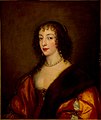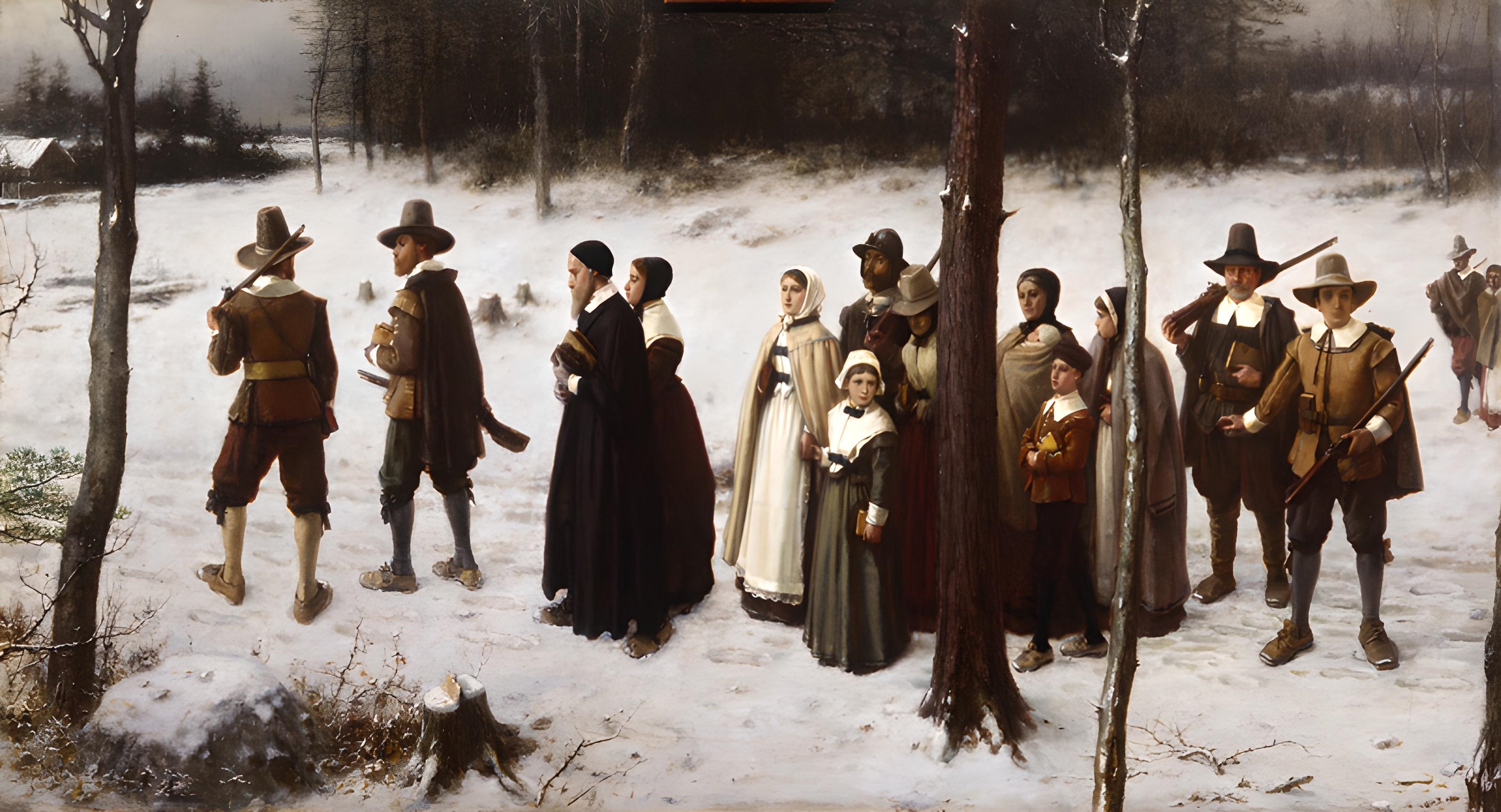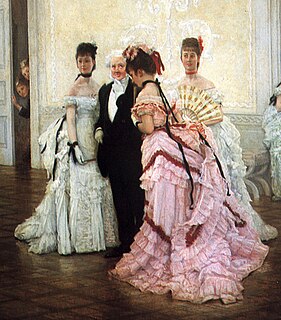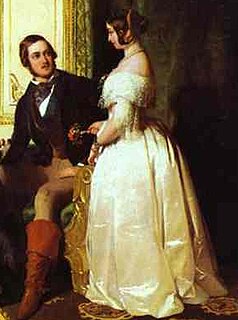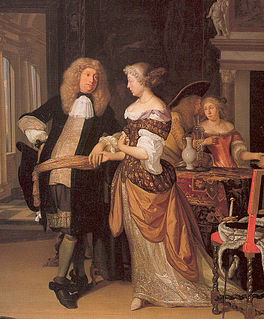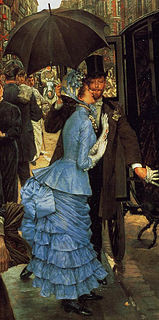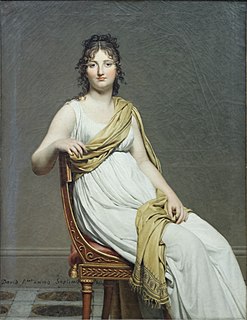
Fashion in the period 1600–1650 in Western European clothing is characterized by the disappearance of the ruff in favour of broad lace or linen collars. Waistlines rose through the period for both men and women. Other notable fashions included full, slashed sleeves and tall or broad hats with brims. For men, hose disappeared in favour of breeches.

Western Europe is the region comprising the western part of Europe. Though the term Western Europe is commonly used, there is no commonly agreed-upon definition of the countries that it encompasses.
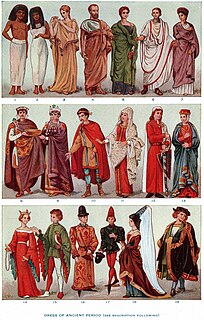
Clothing is a collective term for items worn on the body. Clothing can be made of textiles, animal skin, or other thin sheets of materials put together. The wearing of clothing is mostly restricted to human beings and is a feature of all human societies. The amount and type of clothing worn depend on body type, social, and geographic considerations. Some clothing can be gender-specific.
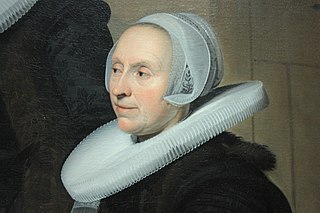
A ruff is an item of clothing worn in Western, Central and Northern Europe from the mid-sixteenth century to the mid-seventeenth century.
Contents
- Fashions influenced by royal courts
- Fabric and patterns
- Portraiture and fantasy
- Women's fashions
- Gowns, bodices, and petticoats
- Hairstyles and headdresses
- Style gallery 1600–1620
- Style gallery 1620s
- Style gallery 1630s
- Style gallery 1640s
- Men's fashions
- Shirts, doublets, and jerkins
- Hose and breeches
- Outerwear
- Hairstyles and Headgear
- Style gallery 1600s–1620s
- Style gallery 1630s–1640s
- Footwear
- Children's fashion
- Simplicity of dress
- Puritan dress
- Working class clothing
- Notes
- References
- Further reading
- External links

The silhouette, which was essentially close to the body with tight sleeves and a low, pointed waist to around 1615, gradually softened and broadened. Sleeves became very full, and in the 1620s and 1630s were often paned or slashed to show the voluminous sleeves of the shirt or chemise beneath.

A sleeve is the part of a garment that covers the arm, or through which the arm passes or slips. The pattern of the sleeve is one of the characteristics of fashion in dress, varying in every country and period. Various survivals of the early forms of sleeve are still found in the different types of academic or other robes. Where the long hanging sleeve is worn it has, as still in China and Japan, been used as a pocket, whence has come the phrase to have up one's sleeve, to have something concealed ready to produce. There are many other proverbial and metaphorical expressions associated with the sleeve, such as to wear one's heart upon one's sleeve, and to laugh in one's sleeve.

A shirt is a cloth garment for the upper body.

A chemise or shift is a classic smock, or a modern type of women's undergarment or dress. Historically a chemise was a simple garment worn next to the skin to protect clothing from sweat and body oils, the precursor to the modern shirts commonly worn in Western nations.
Spanish fashions remained very conservative. The ruff lingered longest in Spain and the Netherlands, but disappeared first for men and later for women in France and England.

Spain, officially the Kingdom of Spain, is a country mostly located on the Iberian Peninsula in Europe. Its territory also includes two archipelagoes: the Canary Islands off the coast of Africa, and the Balearic Islands in the Mediterranean Sea. The African enclaves of Ceuta and Melilla make Spain the only European country to have a physical border with an African country (Morocco). Several small islands in the Alboran Sea are also part of Spanish territory. The country's mainland is bordered to the south and east by the Mediterranean Sea except for a small land boundary with Gibraltar; to the north and northeast by France, Andorra, and the Bay of Biscay; and to the west and northwest by Portugal and the Atlantic Ocean.

The Netherlands is a country located mainly in Northwestern Europe. The European portion of the Netherlands consists of twelve separate provinces that border Germany to the east, Belgium to the south, and the North Sea to the northwest, with maritime borders in the North Sea with Belgium, Germany and the United Kingdom. Including three island territories in the Caribbean Sea—Bonaire, Sint Eustatius and Saba— it forms a constituent country of the Kingdom of the Netherlands. The official language is Dutch, but a secondary official language in the province of Friesland is West Frisian.

France, officially the French Republic, is a country whose territory consists of metropolitan France in Western Europe and several overseas regions and territories. The metropolitan area of France extends from the Mediterranean Sea to the English Channel and the North Sea, and from the Rhine to the Atlantic Ocean. It is bordered by Belgium, Luxembourg and Germany to the northeast, Switzerland and Italy to the east, and Andorra and Spain to the south. The overseas territories include French Guiana in South America and several islands in the Atlantic, Pacific and Indian oceans. The country's 18 integral regions span a combined area of 643,801 square kilometres (248,573 sq mi) and a total population of 67.3 million. France, a sovereign state, is a unitary semi-presidential republic with its capital in Paris, the country's largest city and main cultural and commercial centre. Other major urban areas include Lyon, Marseille, Toulouse, Bordeaux, Lille and Nice.
The social tensions leading to the English Civil War were reflected in English fashion, with the elaborate French styles popular at the courts of James I and his son Charles I contrasting with the sober styles in sadd colours favoured by Puritans and exported to the early settlements of New England (see below).

The English Civil War (1642–1651) was a series of armed conflicts and political machinations between Parliamentarians ("Roundheads") and Royalists ("Cavaliers") over, principally, the manner of England's governance. The first (1642–1646) and second (1648–1649) wars pitted the supporters of King Charles I against the supporters of the Long Parliament, while the third (1649–1651) saw fighting between supporters of King Charles II and supporters of the Rump Parliament. The war ended with the Parliamentarian victory at the Battle of Worcester on 3 September 1651.

Charles I was the monarch over the three kingdoms of England, Scotland, and Ireland from 27 March 1625 until his execution in 1649.
Sadd colors or sad colors were the colors of choice for the clothing of the members of the Massachusetts Bay Colony in seventeenth century America. The Puritans have often been depicted wearing simple black and white, but for them, the color "black" was itself considered too bold for regular use and was reserved for community elders and for highly formal occasions such as when having one's portrait painted. Black was considered so formal in part because black dye was difficult to obtain and black clothing had a tendency to fade to other colors rather quickly. The Puritans, then, designated a set of colors which they called "sadd" colors for their everyday use. These colors were deliberately subdued, and included such named colors as liver color, de Boys, tawney, russet, rust, purple, French green, ginger lyne, deer color, orange, gridolin, puce, folding color, Kendall green, Lincoln green, barry, milly, tuly, and philly mort.
In the early decades of the century, a trend among poets and artists to adopt a fashionable pose of melancholia is reflected in fashion, where the characteristic touches are dark colours, open collars, unbuttoned robes or doublets, and a generally disheveled appearance, accompanied in portraits by world-weary poses and sad expressions.

Melancholia is a concept from ancient or pre-modern medicine. Melancholy was one of the four temperaments matching the four humours. In the 19th century, "melancholia" could be physical as well as mental, and melancholic conditions were classified as such by their common cause rather than by their properties.

































